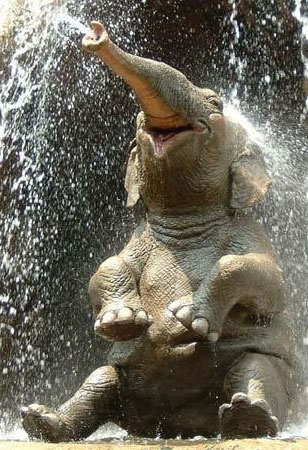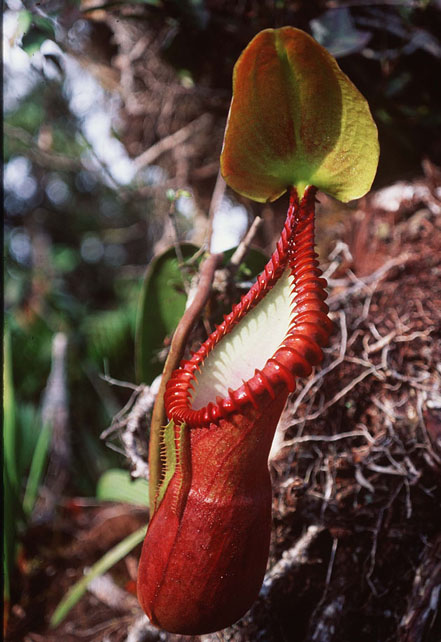Today I'm going to talk about elephants, the adorable, gentle creatures that make me smile. Let's start with the basics.

(Doesn't that just make you smile?)
They are the world's largest animal
Two types of elephant: African and Asia
African elephants inhabit the savannah's south of the Sahara Desert, and rain forests of west and central Africa.
Asian elephants are inhabit India, Sri Lanka, China and much of Southeast Asia
Length of life: Up to 70 years old
Weight: 6,000 to 15,000 pounds (wow, they are big)
Diet: Grasses, leaves, bamboo, bark, roots, banana and sugarcane,
Adult elephants can consume 300-400 pounds of food per day.
When elephants drink, they can suck in up to 2 gallons of water.
Elephants don't have bones in their trunk, just muscle
Number of offspring: 1 calf (which will weight 200-250 pounds at birth!)
They are very intelligent and social animals
The patterns on an elephant's ear are unique and they use their ears to express emotion.
Now that you know all about elephants, let's talk about how in trouble these amazing creatures are. Fair warning, the rest may not be for the squeamish at heart.
This species is in serious trouble, all elephants are endangered. They are killed every day, which is an awful truth. The worst part, we, humans, are the reason for it all. Not just because we are taking away their habitat or polluting their earth, we are directly, inhumanely, killing their gentle gaints. Back in 2007, The Time said that
"23,000 elephants killed each year for ivory".
The rate has increased even more in these last four years. Elephants are killed for one reason: their tusks. Greedy, evil people want to get rich so they kill these animals and sell the ivory tusks. Most of ivory tusks are traded in the black market. Elephants are also killed, on a smaller scale, for their meat. In addition, poachers aren't the only ones hunting these animals. People do it for fun, for a prize. Americans travel to Africa and take safari's that allow them to kill these animals. (Why aren't we condemning this?)Even killing just one or two from a family, which is rare because most poachers kill the entire family at a time. Poachers kill the older elephants because their tusks are larger. This leaves the younger elephants without parents. Sometimes, the poachers don't spend the time to kill the elephant, they just cut off its tusks and leave the animals in pain and forever damaged. Many die within months after their tusks are cut off due to infection and inability to provide for themselves.
Poachers just cut off this elephant to rot after they took it's tusks.
(The men in the picture are anit-poachers, trying to stop this injustice).

There are many other pictures on the Internet, but they are just too gruesome. I was looking through some and it is just horrid and heartbreaking what is occurring to these beautiful creatures. I feel so bad that I'm not doing sometimes about it, that I am not stopping it right now, and at first, when I was younger, I couldn't look at the photos. I refused to see these animals killed or mutilated. I would look away, I wouldn't think about it because I felt so bad for these creatures. But then one day I unwillingly saw the awful pictures of the elephants head cut off (above) and I just stopped. I think I might have started crying and I didn't know what to do. I was angry at the people who did this and then I was angry at myself because I was turning away from it. I was being a coward. I was pretending that if I didn't see it, then the killings wouldn't be occuring. But these animals, and many more, are killed every day, whether I admit it or not. So, I started researching the topic and looking at these pictures, even though it pained me. In 8th grade, I did an entire project on illegal wildlife trade. Part of the presentation included showing pictures of dead elephants and tigers and the bloody remains. My class was shocked. They didn't know this was occurring. They had heard about it, but never actually seen it. For 8th graders, I guess its okay for the majority to not know these actions are occurring. However, it's not okay that the majority of the world is unaware or, if they are aware, not doing anything about it. By not doing about it, by not focusing on this emotional topic, by not protecting these creatures and stopping the trade, we are just as bad the poachers. We aren't holding the guns and the knifes that kill the animals, but we aren't taking them away either.
I was googling elephant killings and injustices and stumbled upon this article. I would highly recommend reading it. Personally, I found it disguting and pathetic that we care so little about the earth that we kill its creatures just because, just to say we could.
You can help by donating money. You can help by adopting a herd or single elephant. You can help by sending letters to environmental agencies. But the best thing you can do is teach people. This cause touches my heart and hopefully it has touched yours. However, poeple just don't know about these creatures so teach them. Elephants could face extinction by 2020. In nine years don't you want to be able to see elephants in the wild. I sure do. I want to see them, I want my kids to see them, I want their kids to see them.
Stay tuned for more,
KZ



